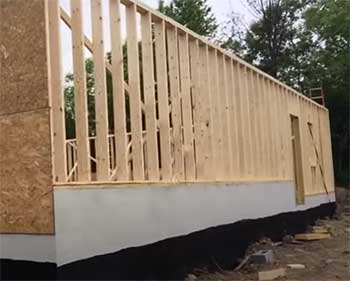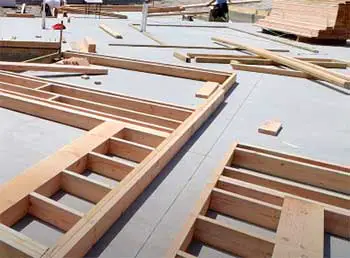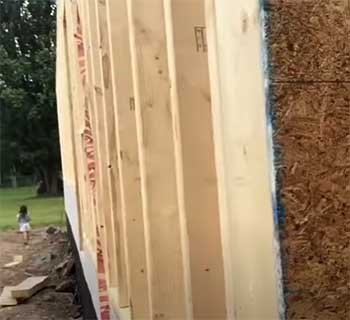You have finally determined to build your dream home and got a professional contractor. But have you decided to use the standard 2×4 or 2×6 exterior walls?
Since most people go with 2×4 exterior walls, you need to know the pros and cons of 2×6 exterior walls before using them.
Unless 2×6 exterior walls add any value to your house construction project, there is no point in using such a type of wall. Let’s get into the main advantages and disadvantages of 2×6 exterior walls.
This will aid you to go on the path to a better decision for picking the option.
The Advantages And Disadvantages Of 2×6 Exterior Walls
Are you in a hurry? Want to have a quick idea about the 2×6 construction benefits and drawbacks? Check this small table to get brief details about 2×6 exterior walls.
| Pros | Cons |
| A better-insulated home | It has an expensive installation cost. |
| Makes the house appears slightly better | It may make your house slightly small. |
| Increases the Sound Transmission Class (STC) rating | Potential Foundation Changes |
| An energy-efficient option | Greater Challenge Aligning Exterior Finishes |
| Meets the standard of tougher fire codes | Potential Moisture Traps |
| Better home protection | Difficult Retrofitting Insulation |
The Advantages Of 2×6 Exterior Walls
Let’s get into the advantages of 2×6 Exterior Walls first. I will mention each of them sequentially to help you learn why you should choose these walls over typical walls.
- A Better Insulated Home

Are you living in a highly cold or hot area? In such as case, you need a better-insulated home.
2×6 exterior walls are a perfect choice to keep your home relatively cool during hot days.
Also, they effectively keep your internal home temperature hot during the colder days.
But ensuring proper insulation is crucial to retain a convenient temperature in your residence.
- Better Home Appearance
This is often an overlooking factor. Due to the extra thickness of door and window jambs, the overall appearance of your home will be rich and classic.
Since it is a unique yet charming feature, you will add extra value when you plan to sell your house. You can demand extra money for being stand out from the rest.
- Increased The Sound Transmission Class (STC) rating
Living in a noisy area? You may have already been fed up with it. Thankfully, 2×6 exterior walls can increase the sound transmission class (STC) rating.
This type of wall effectively reduces outdoor noises inside the home better than 2x4s. The thicker walls ensure a minimal volume of sound will enter your house.
- An Energy-efficient Option
If saving energy is your main goal, 2×6 exterior walls appear one of the best choices. Since it helps you achieve an optimal and comfortable temperature, you need to use the air conditioner or heater for less time.
This will save your overall monthly electricity bills.
Apart from that, it appears to be an eco-friendly option since you are using less of the amount of energy. So, 2×6 exterior walls can keep internal home conditions comfortable for a long time.
Along with it, you will save a lot of money annually.
- Meets The Standard Of Tougher Fire Codes
If you live in a risky area where fire can enter your house from any hazardous issues, 2×6 exterior walls are better than 2×4.
The extra thick layer of construction will prevent fire from getting inside the house easily. In fact, homes with 2×6 exterior walls near fire brigades meet the standard of tougher fire codes.
- Better Home Protection
Your home construction plays a key role in keeping you safe from bad weather. Several studies found that 2×6 exterior walls provide better protection than 2×4 walls.
This thick wall can safeguard your house from heavy storms, hurricanes, and earthquakes. In addition, thicker walls prevent different types of deadly insects from entering homes.
- Less Temperature Variation
Not only do 2×6 walls with more insulation save on energy costs, but they also moderate indoor temperatures. The additional insulation means interior walls stay closer to the desired temp, even as outdoor temps swing up or down. Rooms feel more consistently comfortable.
- Reduced Moisture and Condensation
The extra insulation also helps reduce cold exterior wall temperatures, which lowers the potential for moisture accumulation and condensation within the wall. This added protection limits possibilities for mold growth and rot over the long run.
- Greater Structural Strength

While 2×6 walls with the added insulation do cost more upfront over 2×4 walls, they also provide a stronger wall structure.
The thicker 2×6 studs allow for more load-bearing strength overhead and better anchoring for roof lines/trusses and upper floor framing.
This greater native structural capacity may reduce expenses for additional framing requirements in architectural plans.
- Increased Options for Windows/Doors
With the stronger wall structure, larger window or door openings are more feasibly supported solely by the wall versus having to add supporting headers or lintels. The property gains design freedom for larger sliding doors, big picture windows, or double entry doors without excess framing.
- Higher Resale Value
Energy efficiency, lower utility bills, and greater comfort are all factors home buyers look for. Highlighting the 2×6 exterior walls, expanded insulation, and improved temperature/moisture performance can boost property value at resale. This offset initial building expenses for 2×6 construction.
Disadvantages Of 2×6 Exterior Walls
Though 2×6 exterior walls don’t have too many disadvantages, you should still learn about them. Below are some drawbacks of using 2×6 exterior walls.
- Expensive Installation Cost

Better things have a better price.
Since the thickness of 2×6 Exterior Walls is 2 inches higher than 2×4 walls, you need to spend additional money for each foot.
Hence, you will have to bear a significant amount of extra cost for installing 2×6 Exterior Walls for your home construction.
But it is worth the price you pay in the long run.
- Makes House Slightly Small
If you plan to build a small house, its appearance may look slightly smaller due to the extra layer of 2×6 exterior walls.
They will cover more space in your house and reduce the usable space. This may not be an issue for massive homes but a major factor when trying to get as usable space as possible.
Lastly, watch this short video to understand exactly when to use such walls.
- Potential Foundation Changes
The thicker walls mean shifting the structure’s footprint out another inch on each side. Depending on lot constraints, this may force changes to the depth or design of the foundation to accommodate 2x6s. These changes raise site work and concrete costs.
- Greater Challenge Aligning Exterior Finishes
The thicker walls also cause alignment issues or gaps tying exterior siding/trim materials back to doors, windows, and roof lines. The sheathing surface stands out an extra inch from windows and complicates flashing details. Special attention and additional work trimming out exterior finishes is required.
- Potential Moisture Traps
While the extra wall depth for insulation resists temperature changes/condensation, it also provides more potential space for water or vapor infiltration during storms. Careful, comprehensive air sealing and the use of a drainage-enhanced house wrap helps mitigate this improved risk.
- Difficult Retrofitting Insulation
Unlike 2×4 walls where expanding foam insulation can be injected into empty wall cavities relatively easily, retrofitting insulation into existing 2×6 walls is tough without removing interior wall sheeting.
Homeowners may shy away from needed efficiency upgrades due to cost and disruption.
Frequently Asked Questions (FAQ)
After going through this post, you may have some questions. Here are a few of them.
Most exterior walls are 2×4 since they are more common and affordable options. Plus, not areas of a particular state can build 2×6 exterior walls since it needs to follow local building codes.
The maximum R-value for a 2×6 wall can be up to R-39, while the minimum value is R-19. Generally, R-value is determined by a particular material, thickness, density, and cavity depth.
As per the recommendation of the ICF construction standard, the thickness of exterior walls should be 12 inches, but it will reduce your room size and minimize overall usable spaces.
You can use R-19 or R-21 kraft-faced fiberglass insulation to insulate a 2×6 exterior wall. This type of insulating material can help you maintain an optimal temperature for your house.
Final Thought
So, what have you decided after going through the pros and cons of 2×6 exterior walls?
Should you use this type of wall in your house construction or use the regular version. It is important first to figure out whether your current area has permission to build these walls.
Though the initial investment cost is slightly higher for 2×6 exterior walls, it will provide increased service value in the future. More importantly, you will be able to ensure a comfortable and safer environment inside your house.
